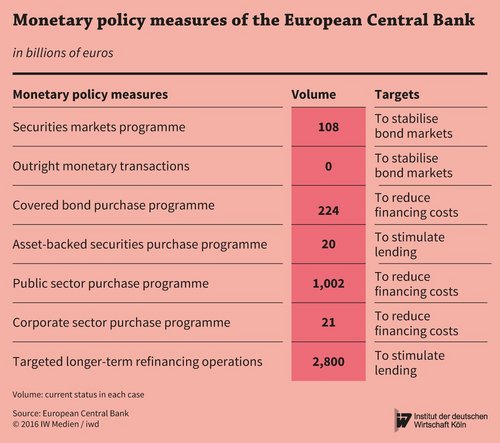Since 2008, the European Central Bank (ECB) has been pulling a series of new monetary policy instruments out of its hat, in an effort to stabilise the markets, to stimulate the economy or – as is presently the case – to normalise inflation. However, since these endeavours haven’t yielded all of the desired results so far, some economists hope that ECB President Mario Draghi will dig even deeper into the bag of tricks surrounding monetary policy. But this isn’t necessary. After all, the policy of low interest rates is working – namely, on the labour market.

Extreme measures
When the global financial system was facing a collapse in 2008, the ECB had to lend a lot of money to the banking sector and had to cut its policy interest rates. At the peak of the euro crisis in 2012, the central bank had to stabilise the markets for government bonds. And today, it’s fighting against the risks of deflation.
The ECB’s billions and trillions
From the very beginning, it’s been about high volumes. The securities purchases, which the ECB conducted from May 2010 to September 2012 to try and stabilise the bond markets that had been heavily hit by the debt crisis, amounted to more than 108 billion euros. What seemed a gigantic amount at the time now appears rather trivial in light of the volumes with which the central bank is now stepping in (see chart).
The ECB’s balance sheet currently includes nearly 21 billion euros of corporate bonds, almost 224 billion euros of covered bond, and over 1 trillion euros of government bonds.
And many billions are still being added to this amount, since the ECB is purchasing further government bonds every month in the amount of 80 billion euros each – which will continue until at least March 2017. Yet since the market for these securities is almost bought out in the meantime, the central bank has been purchasing additionally corporate bonds since June 2016.
However, not all 19 of the Eurosystem’s central banks are participating in this programme – only six of them. For instance, the Deutsche Bundesbank purchases bonds from German and Dutch companies. The National Bank of Belgium purchases bonds from companies in Belgium, Greece, Portugal, Cyprus, Luxembourg, Malta, Slovenia and Slovakia.
While the central banks are only allowed to purchase government bonds in secondary markets – that is, essentially “used” bonds – they are allowed to purchase corporate bonds directly upon issue, even as a private placement (meaning that the central bank conducts a bilateral transaction with a company).
Small- and medium-sized enterprises do not benefit much from this programme, since they are rarely financed through the issuance of bonds, but rather through bank loans. Larger companies, however, can now even issue bonds with negative yields – a phenomenon that also pleases the Federal Ministry of Finance (see chart).
Due to the acute asset shortage prevailing in the markets, German government bonds – which have been regarded as especially safe and liquid – with a maturity of up to 11 years currently have a negative yield. So, investors are actually paying out of pocket.
What’s the good of more extreme measures?
While the ECB’s ultra-expansionary monetary policy has received especially strong critique on the part of German policymakers and the Deutsche Bundesbank, other countries are pushing for even more expansive measures:
Greater negative interest rates. This recommendation comes from US economist Miles Kimball and former US central banker Marvin Goodfried. In their view, this would be a normal reduction of interest rates and thus wouldn’t have any side effects.
But that’s not the case. Most savers have set specific savings goals for their retirement provisions; but if interest income falls away, they have to set aside even more – which means reducing their consumer spending. And this harms the economy.
Investments in infrastructure. Those who support the idea of the central banks financing public investments in infrastructure make reference to former chairman of the US central bank Ben Bernanke. In 2003, he recommended this course of action to Japan’s central bank as a means for overcoming deflation.
This kind of government financing was long taboo for central banks and is explicitly prohibited for the ECB. And with good reason, since the financing of government expenditures by the central bank usually leads to a high rate of inflation; in countries such as Venezuela it even led to hyperinflation of over 120 per cent per year. But the goal of the ECB is not a high rate of inflation, but rather price stability – defined as an annual increase in prices of “below, but close to 2 per cent”.
Helicopter money. Ben Bernanke also proposed picking up on an idea of Nobel laureate Milton Friedman, who passed away in 2006. In a publication in 1969, Friedman wrote that the central bank could throw money from a helicopter, if needed, to battle deflation – though this was likely meant as a figurative scenario. British economist John Muellbauer has now fleshed out this idea and recommends that the ECB should directly wire to every EU citizen an amount of 500 euros, which can then be spent for consumer purposes, thereby allowing prices to increase.
However, such an “end-of-the-year bonus” from the ECB would have direct distributional effects and thus doesn’t constitute monetary policy but rather economic policy – which is not a task of the ECB.
Purchase of stocks. The Japanese central bank has been fighting a hopeless battle against deflation for years now. In the meantime, the central bank has even begun buying stocks.In contrast to a bond, a stock does not mature. So, if the stock is sold at some point in time, it will be done at the then current market price – a risk that central banks generally do not take. Since the purchase of stocks causes prices to increase, companies theoretically have the possibility of financing their investments by issuing new stocks. But common shareholders won’t necessarily like this.
Deflation risks in Europe
Besides the fact that each of these recommendations has clear economic drawbacks or even contradicts the mandate of the ECB, the basic idea of pursuing more and increasingly extreme measures of monetary policy puts Europe on the wrong track. In doing so, the ECB would create the impression that it’s reached the end of its current monetary policy. And this would fuel pessimism – which is the last thing the markets need at this time.
On top of this, the instruments employed so far by the ECB have not achieved the desired outcomes. This is especially true of the fight against deflation. In August 2016, the average rate of inflation in the euro zone was 0.2 per cent, which is far below the targeted 2 per cent; and in eight of the 19 euro countries, inflation was even in negative figures.
The low interest rate policy is working – on the labour market
But that doesn’t mean the ECB’s efforts are completely in vain. Its measures are indeed working – namely, on the labour market. Since the start of the big purchasing programme for government bonds in March 2015, the unemployment rate in the euro zone has decreased by 1.1 percentage points. Remarkable progress could be seen in the crisis countries of Cyprus (-4.4 per cent), Spain (-3.3 per cent), Greece (-2.3 per cent), Portugal (-2.1 per cent) and Ireland (-1.5 per cent).
The reason: Low interest rates relieve companies and give them the chance to recover from the recession. They are then in a position to hire people again, whose consumer spending fuels the economy – which, sooner or later, should help to stabilise inflation to the desired level.
More on the topic

A Macroeconomic Analysis of Wage-Price Spirals
The subject of this Analysis is the forms that wage-price spirals can take and how they influence macroeconomic stability and inflationary trends in Germany.
IW
The Energy Dependence of Bank Loans
Russia's war against Ukraine has highlighted the vulnerability of the Federal Republic of Germany to Russian energy imports, especially natural gas.
IW